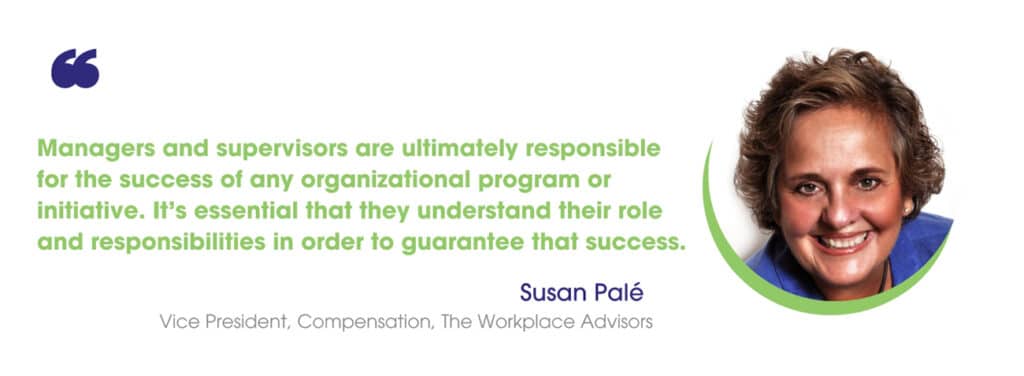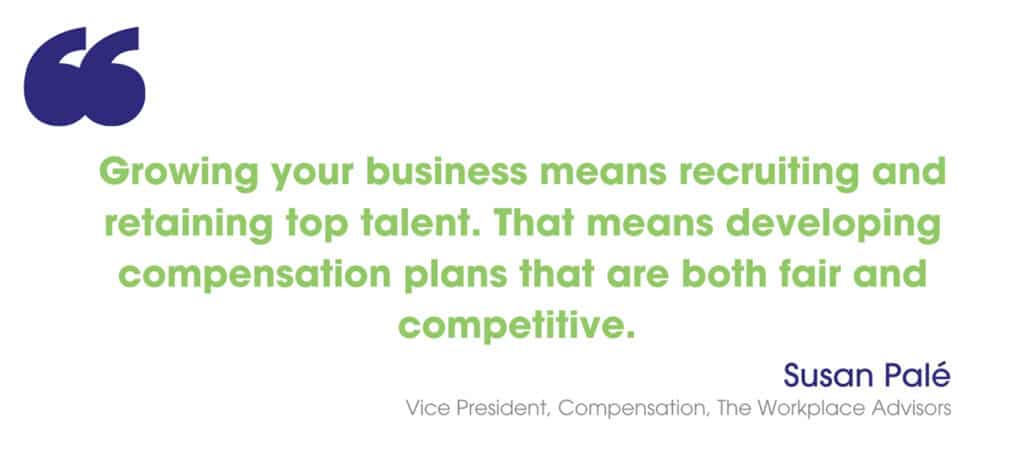The Great Resignation is over, the red-hot recruiting market has cooled a bit, and inflation is down. That’s some of the good news for employers in 2024. But don’t relax too much – compensation is still important. In a recent Compensation Best Practices Report published by Payscale, a majority of employers reported compensation as their biggest challenge – a bigger challenge than either recruitment or retention. And 53% of those employers reported that they would increase focus on development of a compensation strategy for 2024.
To address these challenges, it is time, as an employer, to ask some questions.
Is It Time to Develop Salary Ranges?
Salary ranges, also called salary bands or pay ranges, establish the pay parameters for a job role or group of roles. Salary ranges are based on market information in conjunction with the organization’s compensation strategy and philosophy. Pay ranges typically include a minimum, midpoint and maximum amount.
If your organization is small, market pricing for individual positions can work well. But as a company grows, especially if it expands to multiple locations, finding market information for every job and location becomes difficult.
Salary ranges also provide the framework to promote consistency in offers to new hires and promotions and salary increases for existing employees. In the past, many organizations offered starting salaries to hew hires based on salary history, but it is now illegal in 22 states to ask about an applicant’s salary history. And it’s likely more states will adopt this type of regulation.
Salary ranges can also help to address issues such as salary compression (when salaries of new hires equal or exceed those of experienced employees in the same or similar role), pay equity (equal pay for equal work or work of comparable value) and pay transparency. More about the last one below.

How Will My Organization Address the Issue of Pay Transparency?
Pay transparency is defined by World at Work as “the degree to which employers are open about what, why, how and how much employees are compensated.”
- Pay transparency is often driven by legal requirements.
- Pay transparency laws vary by state, but generally focus on requirements that employers list salary ranges on job postings for open positions.
Compliance with legal requirements often means that current employees find out about pay ranges for their positions from job postings or external applicants. That can certainly cause problems. The same Payscale Best Practices survey noted above reported that 14% of responding employers have lost employees because those employees saw posted job ranges. And legal penalties can be significant. In the state of Washington, which allows remedy through the court system (as opposed to enforcement by a government agency), one law firm filed over 30 class action suits in one week.
But pay transparency is more than compliance. It’s about being proactive in your communications about compensation. That doesn’t necessarily mean that everyone gets to see everyone else’s salaries. That happens in some tech companies, but it’s not common or required. What it does mean is that employees should understand how they are compensated and the rationale that determines their pay.
That might include variables such as:
- Compensable factors (skills, knowledge, education, certification, etc.)
- Performance
- Depth and breadth of experience
- Seniority and length of service
It’s time to be proactive about pay transparency. Even if there aren’t legal requirements in the locations where you do business, you need a compensation strategy that allows you to make offers to candidates and reward current employees within a fair, consistent framework.
What Do Managers and Supervisors Need to Know about Compensation?
In my consulting practice, I’ve often had managers and supervisors tell me that they don’t have an understanding of their organization’s compensation policies and practices. Sometimes the CEO is responsible for compensation decisions and doesn’t effectively communicate the rationale to anyone. That puts managers and supervisors in the awkward position of not being able to answer employees’ questions about their pay.
There are steps you can take to help your managers and supervisors. These include:
- Documenting and distributing your compensation philosophy, policies, and procedures
- Training managers to provide them with the skills and knowledge to answer employee questions and communicate consistently about compensation
- Maintaining an open-door policy to discuss compensation questions and concerns with all employees (and encouraging your managers to do that too)
- Empowering your managers to make compensation decisions for their new hires and current employees
Managers and supervisors are ultimately responsible for the success of any organizational program or initiative. It’s essential that they understand their role and responsibilities in order to guarantee that success.

Do Employees Understand Their Total Compensation?
Total Compensation (also known as Total Rewards) includes not just base salary and other cash payments, but also the value of all employee benefits and perquisites that can be quantified. For many organizations, the cost of benefits, including healthcare premiums, retirement plan contributions and paid time off can easily amount to 30% – 35% of an employee’s salary. That means the total compensation for an employee making $100,000 would be $130,000 – $135,000.
A 2023 survey conducted by beqom (a provider of total compensation management software) revealed that nearly half of surveyed employees don’t understand their total compensation.
Organizations generally do a pretty good job of communicating total rewards when posting positions or interviewing candidates – after all, those are great marketing opportunities. But these same organizations often don’t do a very good job of communicating total compensation to their current employees.
One way for an organization to improve total compensation communications is through a total rewards statement. A total rewards statement is an extremely effective tool to help employees understand the true value of working for the organization. Statements are personalized and typically produced and distributed once a year.
In the past, these types of statements have focused on quantifiable information. That includes financial information about base salary and bonus/incentive payments, and benefits information including medical plan contributions, PTO, 401(k) contributions, etc. But there is now a current trend to include non-quantifiable information in these statements. That might include things like opportunities for remote or hybrid work, flexible and in-advance scheduling, and educational opportunities.
Growing your business means recruiting and retaining top talent. That means developing compensation plans that are both fair and competitive. It’s a tough landscape to navigate, but answering these questions will help you get off to a good start.
Q&A with The Workplace Advisors
Question: What do I need to know about hiring a summer intern?
Answer: If you plan to pay your interns at least minimum wage, you’re in good shape. If, however, you are planning to offer an unpaid internship, there are a few things you should consider.
Federal and state governments are cracking down on the use of unpaid interns, arguing that not paying interns for their labor violates the Fair Labor Standards Act (FLSA).
Even if you and your intern agree that the work experience is sufficient compensation for the labor, you must satisfy the requirements for it to be “bona fide” and thus qualify as an unpaid internship.
You may be subject to wage and hour penalties and back wages under the FLSA if you fail to pay your summer interns appropriately.
The Wage and Hour Division of the US Department of Labor’s Fact Sheet #71 offers help for determining whether your intern is entitled to minimum wage or overtime pay.
For the record, we are strong proponents of internships, particularly as a means of identifying and developing new talent and future employees. Good luck!
Palé is vice president, compensation, at The Workplace Advisors, Inc., formerly Affinity HR Group Inc. The Workplace Advisors specializes in providing human resources assistance to associations such as PPAI and their member companies. To learn more, visit www.theworkplaceadvisors.com.


